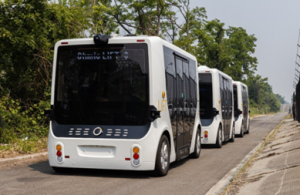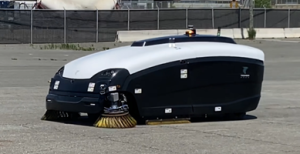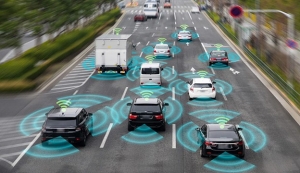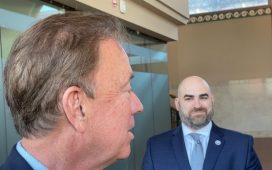Transportation agency chief technology officers (CTOs) are at the forefront of digital transformation in transportation. From deploying smart infrastructure to strengthening cybersecurity, they are shaping the future of mobility with emerging technologies.
On April 17, Eno hosted a webinar with three of the nation’s most innovative transportation CTOs: Robert Galvin, Mike Nguyen, and Cordell Schachter. Galvin is the CTO at the Port Authority of New York and New Jersey, an agency that owns and operates much of the New York metropolitan area’s transportation infrastructure, including bridges, tunnels, airports, seaports, bus stations, and rail facilities. Nguyen serves as the CTO at California’s Department of Transportation (Caltrans), where he oversees a workforce of more than 400 technology professionals. Schachter has served as CTO at New York City DOT as well as a similar role (chief information officer) at US DOT. Government Technology magazine named him one of the nation’s top 25 “Doers, Dreamers & Drivers.”
The three CTOs have overseen programs and systems that support all aspects of transportation from real-time traffic management to transit fare systems. They are also driving strategy, innovation, and transformation relating to emerging technologies.
Changing Mission
Galvin said, “it used to be when you were a CTO, your mission was clear. Keep the systems up inside the organization.” Agencies created and then supported a virtual infrastructure of digital services for traffic management, inspections, permitting, mapping, data, and communications. Now, Galvin said, his agency is increasingly focused on “public-facing applications for our customers” such as real-time information for train riders and dispatching apps for taxi drivers at its airports.
Three Port Authority pilot projects reveal the rapid technological advances, underway. The Authority is testing technology that uses cameras to identify safety hazards, fading crosswalk lines, missing street signs, potholes, and pavement cracks. In New Jersey, it deployed autonomous street sweepers to clean streets, warehouses, and parking lots. At JFK airport, autonomous shuttle buses are carrying airport passengers. The agency has been evaluating these technologies to determine how they perform in all kinds of weather, traffic, and debris conditions.

Autonomous shuttles at JFK Airport. Source: Port Authority of NY and NJ.

Autonomous sweet sweeper. Source: Port Authority of NY and NJ
Vehicle-to-Everything
The panelists are increasingly focused on embedding technologies into the physical infrastructure. Schachter said when agencies install and replace signage, lighting, and roads — they should incorporate instrumentation and connectivity that will provide the foundation for innovation.
Nguyen said Caltrans has nearly a thousand technology-related devices deployed on its roadways and intersections, including those connected to alerts informing drivers about work zones, traffic, and wrong way drivers. “Next,” he said, “we are going to develop standards and architecture for V2X.”
V2X refers to Vehicle-to-Everything, a set of technologies that allow drivers to share camera and sensor data with other vehicles. Data can also be shared between vehicles and roadway infrastructure. With these technologies, drivers can be alerted to a wide range of timely information including broken-down vehicles, construction, potholes, traffic, pedestrians, vehicles braking ahead, and alternate routes.

U.S. DOT Volpe Center image of connected vehicles.
No Shortage of Things to Worry About
Eno’s moderator asked the webinar panelists: “What keeps you awake at night?”
Nguyen worries about the 400 legacy systems used by Caltrans that are no longer supported by staff and vendors. He said people have moved on and retired, and the agency does not have the time, money, and expertise to modernize them all, at this time. He is concerned about operations that could be disrupted, if and when these systems fail.
Galvin loses sleep about the quantum computing problem that he refers to as the “Y2K for this generation to solve.” He explained how computers use encryption algorithms to scramble data so that hackers cannot intercept communications. Encryption protects all the data on the Internet from our texts, emails, and online purchases to a transportation agency’s command center that integrates voice, videos, and text.
“The underlying encryption technology is based on some very difficult math problems that take traditional computers long periods of time to solve,” Galvin said. In the next few years, he warned, sophisticated quantum computers will be able to break current encryption methods in fractions of a second, potentially exposing all our data to malicious actors.
In response to the question on what keeps him awake at night, Schachter said, “I’ll start off with my wise guy response. I don’t really have any trouble. At night I sleep like a baby. I wake up every two hours and scream.”
In a more serious tone, he talked about workforce shortages of technology professionals and noted that transportation agencies need to do a better job of recruiting, retaining, and retraining a qualified motivated workforce. He said, “I’m concerned that recent staff cuts and brain drain at US DOT are risking the future success of innovations. We’re losing expertise and also discouraging young people from considering government as a career.”
All three panelists talked about their concerns relating to cybersecurity. They were well aware that cyberattackers have been able to penetrate numerous systems operated by transportation agencies. For instance, in recent months, hackers have disrupted operations at the Port of Seattle, Pittsburgh’s transit authority, and Transport for London.
Galvin warned that while federal policy changes are generating friction around the world, “We cannot afford to lower our defensive shields when it comes to cybersecurity threats and we need to support the teams that provide critical information to our organizations who are responsible for cybersecurity.” State and local transportation agencies rely on information from federal officials to help them recognize potential threats and indications that their systems have been compromised.
When Schachter revealed that US DOT’s systems get attacked “thousands of times every day,” the other panelists were not at all surprised. Schacter said, “If we don’t fend off those attacks, we won’t be able to perform our various missions, and some of those are important not just to the economy, but also for national security.” He said few policy makers are aware that our older systems tend not to be well protected, compared to more modern systems. “They don’t understand how potentially vulnerable we are.”
Galvin said most malicious traffic at the Port Authority gets filtered out by its firewalls. He said, “You never really see it, but it’s getting worse.” He described how anyone can download “a bunch of malware, point it at some domain, and just see what happens; they might not know what they’re doing, but if they break in it’s bad.” Nguyen said, “Nowadays, what’s scary is that they have a lot of ways to get through your firewalls” including through phishing emails. Galvin added, you can even “hire a service to break into somebody’s system, it’s kind of a scary environment to operate in.”
Partnerships & Planning
Panelists talked about the importance of planning and partnerships.
Galvin is working on a five-year plan for the Port Authority that will include upgrading the communications network which connects all the authority’s facilities (such as the 8,000 cameras that stream into one centralized operation center.) Nguyen described how an important component of the Caltrans technology plan is replacing devices that are coming to the end of their useful lives, before they break and disrupt travelers and business operations.
All the panelists said innovation requires building relationships and partnerships with the public and private sectors. Nguyen said his work at Caltrans is “all about collaboration, collaboration, and collaboration with my team and the internal business partners to really build a solid foundation for us to thrive.” Galvin mentioned that the Port Authority is a leading sponsor of Transit Tech Lab, a program that helps small firms solve challenges for the largest transit agencies in North America. Since 2018, the Lab has helped transit agencies test 51 new technology solutions, pilot 21 integrated solutions, and deploy 8 at scale.
On May 13, Eno will host a webinar on artificial intelligence at transportation agencies. Information about Eno’s webinars is available at https://enotrans.org/resources/webinars/.







